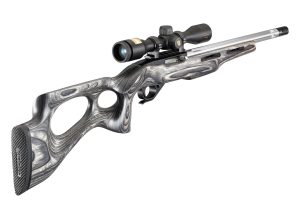Four Things You Can Do With a Rifle (Besides Hunt)
Rifles Can Hunt and So Much More
Although I hunt a little bit, mostly ducks and geese, my friend Barbara is hardcore and chases down ill-tempered wild boars with flint knives—at least that’s what I’ve heard, and I’m sticking by that story.
My interest in guns and shooting are primarily a result of, well, guns and shooting. While I enjoy hunting, my primary interest is shooting just for the sake of shooting.
Embrace History
Rifles, perhaps even more than pistols, can have incredible stories to tell. When I first became interested in shooting, my first 10 gun purchases were old battle rifles; to be specific, I made a field trip to the Civilian Marksmanship Program sales center in Camp Perry, Ohio, to handpick some history. If you’re not aware of the CMP, check out its website, www.odcmp.com. It’s a government-chartered (not government-operated) organization founded as part of the 1903 War Appropriations Act, the idea to aid the militia become proficient and safe marksmen.
As part of the charter, CMP sells surplus rifles and ammunition. It sold me a Springfield Armory 1903 A3 bolt-action rifle, and an M1 Garand manufactured in January of 1945. Every time I shoot those rifles, I wonder where they’ve been. Did they make an ocean crossing to Europe or the Pacific islands? Or were they used for training and coastal defense here at home? I’ll never know, but will always wonder.
Walk through any gun show and you’re bound to find hundreds of guns with stories. Old West? World Wars? The first shooting competitions? You never know. Whether you plan to actually shoot an old rifle with a story or simply own one for the sake of owning something nostalgic, it’s a fantastic way to hold a tangible piece of history.
Defend Your Home
Contrary to popular assumption, rifles can be a great home-defense option. However, unless you live somewhere like Encampment, Wyoming, you need to worry about over-penetration. Consequently, using your .30-06 deer rifle for home-defense isn’t necessarily a great idea, as projectiles from such a high powered firearm can travel through walls, houses, trees, cars, and who knows what else.
For those who live where a rifle for home-defense use can make sense, know that rifles are generally easier to shoot more accurately under stress than are handguns. There are three reasons for this. First, you support a rifle with two hands and with the gun (generally) braced in your shoulder pocket, your full body lending steadiness to the gun in a way it can’t a handgun. Second, the sight radius, the distance between sights, is longer, so small movements in the sight picture do not translate into big misses as can be the case with a handgun. Finally, rifles offer near infinite customization capability. Lights, lasers, grips and slings can all be added and tweaked to your exact preference.
Compete
With a quick Internet search, you’ll likely find a variety of types of local rifle competitions in your area. Here’s an overview of the different types of rifle shooting competition.
Rifle shooting competitions are a great way to improve your shooting skills, while having fun in the process. As many local competitions use .22LR rifles (and even air rifles at indoor ranges), you can get started for a reasonable cash outlay.
If you’re not ready to mix it up with other competitors, check out the National Rifle Association’s Marksmanship Qualification Program, sponsored by Winchester. It’s a self-administered program that runs on the honor system. A free booklet will walk you through shooting challenges for all types of rifle and pistol shooting. For example, the Smallbore Qualification Program develops and tracks your skills over prone, sitting and standing shooting positions. As your skills improve, as measured your specific target performance, you earn merit badge certifications for Pro Marksman, Marksman, Marksman 1st Class, Sharpshooter, Expert, and Distinguished Expert. There are more than a dozen different programs for rifles and shooting disciplines of all types, and I highly recommend trying the program out. It’s even easy to make it a family activity, one that provides some structure to your range outings.
Plink
I saved the best for last. While many believe that baseball is America’s favorite pastime, many of us would beg to differ in favor of plinking. What’s plinking? It’s pure, unadulterated, unstructured shooting fun. When you go to the range with a pile of tin cans to shoot, that’s plinking. When you bet your kids you can hit a dirt clod with a .22LR round faster than they can, that’s plinking. Get the idea?
The best part about rifle plinking is that you can do it with any gun you already have, provided you’re plinking at a range with proper backstops. If you don’t have much space, consider an air rifle; hitting smaller targets at closer distances is satisfying and fun too. If you have a range nearby, invest in a .22LR rifle. You’ll enjoy that forever and at less cost than moving to a larger caliber. Still, if all you have is a larger caliber rifle, you can plink with that too, just look for the less expensive ammunition designated as practice rounds, so you don’t break the bank.
When taking first-time shooters to the range, I always start them off shooting something like a Ruger 10/22 or CZ 513 .22LR rifle, and I use fun targets like tin cans. A smallbore rifle is easier to aim than a pistol, and has no recoil and minimal noise. You can’t beat the satisfaction of exploding dirt clods and making tin cans dance.
Interested in hunting? Great, knock yourself out and get a good rifle. But if you haven’t gotten the hunting bug, don’t assume rifles aren’t for you. Collecting, defending your home, competing, and plinking are all perfectly good uses for a rifle, too.
